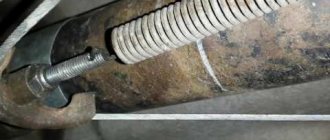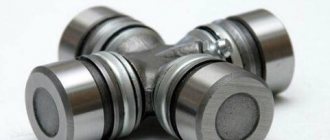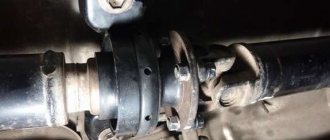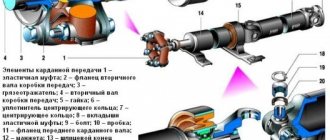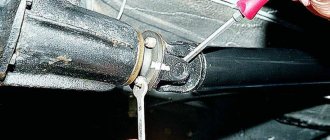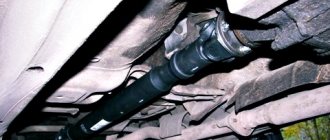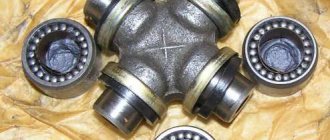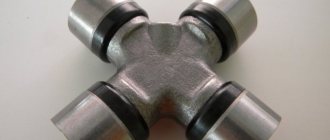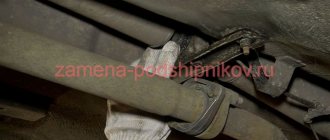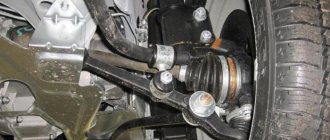Vibration in the transmission device may not be felt. But even a slight runout must be eliminated: this is done by balancing the cardan, this service is provided by a technician.
The condition of the transmission mechanisms should be constantly monitored. One of the stages of checking their condition is vibration diagnostics, which is carried out using special equipment and makes it possible to identify even minimal deviations from the norm. Based on its results, the presence of a beat and its intensity, as well as a method for eliminating it, are determined.
Video of cardan balancing in the garage
The higher the angular velocity of the part, the greater the likelihood of its imbalance, and vibration can be eliminated only and exclusively on complex balancing machines. Moreover, the larger the part, the more complex the equipment should be. Balancing the driveshaft with your own hands, video attempts of which we presented below, as a rule, gives only psychological results, but by no means real ones.
The fact is that it is possible to eliminate the balance of the cardan transmission only if the location and weight of the imbalance are accurately verified, and the cardan must be balanced exclusively in the assembly with the crosspieces. In a garage and without balancing equipment, this is only possible with a cardan installed on the car. Technologically this is impossible to accomplish. Eliminating the imbalance itself is a matter of five minutes, but the main thing is to calculate the exact location, cause and eliminate it.
Causes of imbalance
The following can contribute to shaft malfunction:
- natural wear of the part during long-term continuous use;
- failure to comply with technical regulations for the use and maintenance of the machine;
- manufacturing defects;
- mechanical damage that occurs when interacting with a solid object, etc.
A sign that an unbalanced condition of the shaft has arisen is an increase in the level of vibration of the cardan when driving to the point of discomfort for the driver and passenger in the car.
What is an imbalance and how to eliminate it
The main sources of vibration in a car are large parts with high angular velocity, namely: the driveshaft, automatic transmission torque converter, wheel, crankshaft and flywheel with clutch assembly. If the center of mass of a part does not coincide with the longitudinal axis along which the part rotates, an imbalance will inevitably occur. From a physics point of view, imbalance is the product of the weight of the part and the mass of the eccentricity.
Balancing the driveshaft is the only effective method for removing imbalance. To eliminate it, it is necessary to attach a load to the cardan that is equal in weight, but opposite in sign to the eccentricity. In this case, it is very important to maintain the coincidence of the axes and the location of the suspensions when balancing with the axes and suspension points in real working conditions. In cases with those parts whose length is significantly less than the axis of rotation (wheel, flywheel), it is enough to hang the part by only one point, which greatly simplifies the balancing work. It is also necessary to take into account that the rolling resistance at the suspension point should be minimal and the accuracy of determining the location and module of the imbalance often depends on this. The part simply rotates and stops at the place where the unbalance point is at the bottom. All that remains is to simply mark this point and install a correction weight, and then repeat the operation.
Car operating rules
In order for the driveshaft to last longer, you must follow some rules that will help the part be subjected to less stress during operation:
- Try to limit driving on uneven roads, as constant shaking will negatively affect the geometry of the driveshaft.
- Drive away smoothly, avoiding unnecessary slipping and sudden starts, which significantly increase the load on the vehicle's chassis.
- Once you get into a hole, try to get out of it smoothly, without rocking the car. Carry special mats with you to place under the wheels to minimize the risk of breaking the chassis or driveshaft.
- Do not shift gears abruptly to reduce the load on the special elastic coupling.
- Contact a car service in a timely manner for a complete diagnosis of the vehicle, as well as for advice on car repair and maintenance.
- Do not wash driveline components with high pressure, as water may enter the system;
- Do not heat the shaft when trying to remove old paint - this will disrupt the uniformity of the metal;
- Periodically check the tightness of the fasteners to prevent them from loosening and increasing the load on the moving parts.
- Use lubricants recommended by the manufacturer to protect connections from wear due to sliding.
- Avoid excessive loads on the transmission and driving at high speeds.
Features of balancing the cardan drive
In the case of a cardan shaft, we are dealing with a part whose length significantly exceeds its diameter, and the imbalance may have the same module, but a different direction vector. This is called moment imbalance and can only be calculated using driveshaft balancing equipment. Such vibrations can only be treated with dynamic balancing, which requires calculating and eliminating several imbalances at once.
An imbalance of the cardan can occur not only due to its damage, but also in some other cases:
- factory defects (different cardan pipe wall thicknesses, poor-quality and incorrect fixation of the lugs);
- the occurrence of gaps in the cardan transmission elements;
- curvature of the shaft itself;
- spline wear.
In addition, in most cases, dynamic balancing of the new cardan is necessary, and after each repair, the cardan shaft must be balanced. The price of this operation in special centers depends on the car model, and the approximate cost of the work is given in the table.
Signs and causes of imbalance
The main sign of an unbalanced driveshaft of a car is the appearance of vibration in the entire body of the car. Moreover, it increases as the speed increases, and depending on the degree of imbalance, it can appear both at a speed of 60-70 km/h and at more than 100 kilometers per hour. This is a consequence of the fact that when the shaft rotates, its center of gravity shifts, and the resulting centrifugal force “throws” the car on the road. An additional sign, in addition to vibration, is the appearance of a characteristic hum emanating from under the bottom of the car.
Imbalance is very harmful to the transmission and chassis of the car. Therefore, when the slightest signs of it appear, it is necessary to balance the “universal shaft” on the machine.
Neglecting a breakdown can lead to such consequences
There are several reasons for this breakdown. Among them:
- natural wear of the part during long-term use;
- mechanical deformations caused by impacts or excessive loads;
- manufacturing defects;
- large gaps between the individual elements of the shaft (if it is not solid).
The vibration felt in the cabin may not come from the driveshaft, but from unbalanced wheels.
Regardless of the reasons, if the symptoms described above appear, it is necessary to check for imbalance. Repair work can also be done in your own garage.
How to balance a driveshaft yourself
Based on the information received, it is clear that without special equipment there can be no talk of any precise balancing. However, if a situation arises where it is necessary to carry out balancing, but there is no such workshop nearby, as a temporary measure you can do the following:
- the cardan is conventionally divided in the longitudinal plane into 6-8 parts;
- a weight (15-30 g) is attached to each of the sectors in turn; this can be a weight for balancing wheels;
- the car is taken out onto a flat road and a check is carried out to determine whether the vibration has been eliminated or has become even greater;
- After this, the cargo is moved to another sector.
It is clear that this method will only remove the main imbalance and in no way claims to be accurate, but it will allow you to get rid of vibrations for a while and get to the service station. Make sure the rotating parts are balanced and enjoy your travels!
Second level heading
But the most common cause of failure is deformation of all shafts due to damage during operation, as well as mechanical or thermal treatment. Shaft balancing is a necessary thing.
Third level heading
There are several possible reasons for the negative change. First of all, this may be due to the initial incorrect adherence to the exact dimensions of individual parts of the cardan transmission during their production.
Heterogeneity or uneven density of the material from which the parts were made can also ultimately cause the cardan to quickly become unbalanced.
The reasons also include insufficient accuracy of the overall centering of the joints of the parts, the presence of air gaps in the nodal and detailed joints and the mismatch of their axes when installing the cardan. It is necessary to balance the shafts.
What not to do
If the splines have come apart, you should not listen to advice like “You can simply move around the spline and when the imbalance goes away, this is the correct position.” Firstly, it’s wrong, and secondly, it takes a very long time.
By changing the position of the splines, you will achieve a reduction in vibration, but with a high probability you will not find the correct position of the cardan. The imbalance will decrease, the feeling of vibration in the body will disappear, but a small, imperceptible vibration on the cardan will remain.
Minor vibration can quickly destroy the outboard bearing and crosspiece. It is also likely that the gearbox, axle or transfer case will suffer - usually the first signs are leaking seals.
Types of balancing
- Static. It is used to detect and eliminate rotor imbalance without taking into account the forces generated during rotation. To statically balance the rotor, it is necessary to shift its center of gravity so that the axis of rotation passes through it. Used for disc rotors with a length to diameter ratio of no more than 1/4. This balancing is performed on the correction plane and is not suitable for a cardan drive.
- Instant. To perform this balancing, the unbalanced torque of the main shaft, which is an indicator of the torque imbalance of that rotor, is determined and reduced. This is done in at least two correction planes.
- Dynamic. Includes static and instantaneous. Used for long rotors. Ideal for balancing drive shafts. Therefore, cardan balancing is performed on equipment that uses this method.
Looking at the process of balancing a bench, it is impossible to understand what method is being used. The operation of all supports looks the same - the shaft rotates, and the display shows the position and magnitude of the imbalance.
Disassembly and assembly of the cardan
In order to avoid the need to balance the driveshaft after fixing it with your own hands, it is necessary to note the position of the shafts from which it is made relative to each other. And when you lift the driveshaft, be sure to line up the marked marks. You can see how to do this in the video. If you forgot to mark the location of the driveshaft components before disassembling, another video will help eliminate the resulting vibration.
When is cardan balancing necessary?
- When replacing the driveshaft (shortening, lengthening, etc.).
- After elimination, significant deformation of the cardan, which is a consequence, for example, of a strong impact.
The first symptoms of wheel imbalance
Before wondering where to balance the driveshaft, you need to learn about the most common symptoms of a problem in order to determine in time when you need to take your car to a service center:
- When accelerating to certain speeds, a strong vibration is felt in the car. Moreover, the stronger it becomes, the more the wheels become imbalanced. Strong shaking is dangerous because the car can skid (especially in the winter season).
- Extraneous noises during a trip are also a kind of symbol of the fact that the car is gradually beginning to break down in the area of the cardan and other parts related directly to the vehicle’s chassis system.
Note! Since the driveshaft includes many small parts, they often fail before others. Therefore, it is often necessary to resort to complete replacement of components that are relatively inexpensive. There is no need to skimp on this by trying to manually restore the part, since any intervention can lead to complete failure of the unit.
What else is important to remember?
- There is one malfunction that may prevent the weight cardan from being balanced. It appears when workers use hammers to hit the flanges of the gearbox and the propeller shaft itself when trying to remove or install the shaft. It is unacceptable! A small hammer blow to the flange seat will cause a large imbalance.
- Cheap crosspieces from incompetent manufacturers are easily pressed, let water through and quickly fail, so you shouldn’t skimp on crosspieces! Poor-quality crosspieces may begin to rotate not in the bearing, but in the seat, that is, in the eye of the flanges and propeller shaft. This causes wear of the metal, damage to the lugs and their unraveling, which can lead to breakage and destruction of the driveshaft while driving. Even a few hours of running on such crosspieces will make it impossible to install new crosspieces. The seat will be damaged and the entire driveshaft will have to be replaced.
- If you have a choice between cores and retaining rings, it is better to choose rings. They save the crosspiece bearing seat from incorrect core punching and increase the crosspiece's mileage several times. We are against coreing, just like our German partners, who indicate in the documentation for the cored cardan that its crosspieces do not change - it is disposable. Remember: even mechanical welding is better than punching because the hole remains round.
How is the condition of the driveshaft determined?
For high-quality repairs, it is important to accurately determine the condition of the shaft, identify all defects and causes of vibration. To accurately determine the cause of vibration, it is necessary to remove the driveshaft from the car in advance in a car service center. If this is not done, the transmission elements will not allow you to easily get to the cardan and determine the causes of the imbalance. When you bring the removed driveshaft to us, for an accurate diagnosis, we install the removed driveshaft on a balancing machine - it is specially designed to detect vibrations. Let's tell you more about the 2 main elements: the pipe and the cross.
Pipe
- one of the main elements of the cardan. Unfortunately, it receives undeservedly little attention. The current condition of the pipe and the quality of factory production greatly affect not only safety, but also the car’s mileage and driving comfort. For example, for business class cars this is a priority. A poorly welded, low-quality or deformed pipe cannot be balanced - it will have to be replaced completely.
Cross
- an element that requires even more attention, since it is a bearing that needs to be lubricated. Incorrect lubrication can destroy the spider. And low-quality hinges will not allow balancing. The correct installation of bearings in the seat and experience are also of great importance. We have enormous expertise, so we can even install retaining rings for machines with maintenance-free Hooke joints. This allows owners to change them more than once.
When necessary, we can supplement diagnostics with remote noise and vibration sensors. With their help, you can wirelessly find out where noise and vibration are coming from, even on a rotating shaft.
What malfunctions can cardan vibration be confused with?
- Gearbox bearing wear;
- Gearbox bearing wear;
- Wheel bearing wear;
- Unbalanced wheels;
- Torn off engine mount;
- Broken gear tooth;
- Injection nozzle not working (tribbing).
Vibration usually occurs at speeds between 60 and 80 km/h.
If the vibration activity is not strong, you can get to the nearest car service center on your own. But it’s better not to tempt fate, stop and inspect the shaft. Important: if it starts to vibrate at speeds below 60 km/h, it is extremely dangerous! Such a universal joint can tear off the mounting bolts and fly out onto the road in any direction. It is also capable of tearing off the muffler, damaging the gearbox, bending the gearbox flanges, breaking the handbrake cables, and even colliding with the rear axle, making the car uncontrollable.
Terminology
- Imbalance is a mismatch between the axis of rotation of a body and its main axis of inertia. This imbalance of the rotating elements of propeller shafts or other rotors causes vibration. The latter will cause fatigue cracks in the cardan support, which will quickly develop into breakdowns. Threaded connections subject to vibration gradually become loose and untwisted. This can lead to an emergency situation due to the gimbal falling while the vehicle is moving. In addition, vibrations have a negative impact on the driver: they contribute to rapid fatigue and distract him from assessing the road situation, and also increase the risk of an accident.
- The main axis of inertia of a tree is the axis of symmetry passing through its center of mass.
- Balancing transmission shafts is the process of eliminating their imbalance, which consists of moving the main axis of inertia until it is aligned with the axis of rotation.
